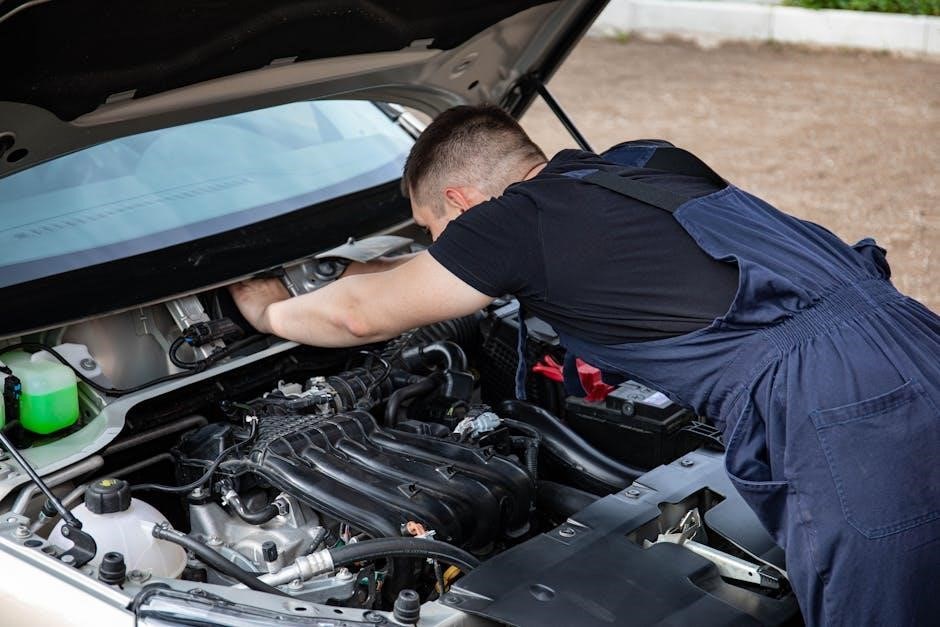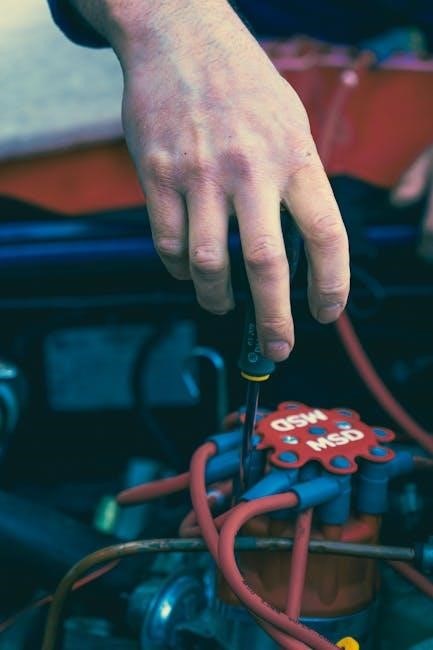Understanding ‘Engine Idled See Manual’
The message “Engine Idled See Manual” signals a potential issue requiring immediate attention․ Consulting the vehicle’s manual is crucial for understanding the specific problem and recommended actions․ This provides vital safety information․
Initial Assessment and Manual Reference
When the message “Engine Idled See Manual” appears, the initial step involves a comprehensive assessment․ This includes noting any unusual engine behavior, such as rough idling or stalling․ The vehicle’s manual is the primary resource for deciphering this message․ It offers specific troubleshooting steps tailored to your car model․ Reviewing the manual can provide insights into potential causes․ It can also explain recommended diagnostic procedures․ Ignoring this message could lead to further engine damage․ Therefore, prompt action is necessary․ The manual might suggest checking certain components or sensors․ Following these instructions can help identify the root cause․ Always prioritize safety when performing any inspections․ If unsure, seek professional assistance․
Common Causes of Engine Idling Issues
Rough idling can stem from various issues, including vacuum leaks affecting air-fuel mixture, faulty PCV valves, bad ignition coils, and oxygen sensor malfunctions․ Addressing these is vital for smooth operation․
Vacuum Leaks and Air-Fuel Mixture
Vacuum leaks disrupt the delicate air-fuel mixture, leading to unstable idling․ These leaks introduce excess air into the system, causing the engine to run lean․ This imbalance often results in a rough or uneven idle, stalling, and reduced acceleration, especially at low speeds․ Identifying and sealing vacuum leaks is essential for restoring proper engine performance․ Inspect vacuum hoses and intake manifold connections for any signs of damage or wear, as these are common sources of leaks․ Addressing these leaks ensures a stable and efficient engine idle, preventing further complications and maintaining optimal fuel economy․
Faulty PCV Valve
A faulty PCV (Positive Crankcase Ventilation) valve can cause a rough idle, engine misfires, and a surging idle․ The PCV valve regulates crankcase pressure, and when it fails, it can disrupt the air-fuel mixture․ This disruption often leads to an unstable idle, as the engine struggles to maintain a consistent RPM․ Symptoms of a bad PCV valve include a rough idle, engine misfires, and a check engine light․ Replacing a faulty PCV valve is crucial for restoring proper engine function and preventing further issues․ Ensure to inspect and replace the PCV valve to maintain a smooth and stable engine idle․
Bad Ignition Coils
Bad ignition coils are a common cause of engine acceleration problems and can also lead to a rough idle․ Ignition coils are responsible for providing the spark needed to ignite the air-fuel mixture in the engine’s cylinders․ When an ignition coil fails, it can cause misfires, leading to an unstable idle and reduced engine performance․ Symptoms of bad ignition coils include a rough idle, engine misfires, and the check engine light illuminating․ Replacing faulty ignition coils can restore proper engine function and eliminate the rough idle․ Ensure all ignition coils are functioning correctly to maintain a smooth and stable engine idle․
Oxygen Sensor Problems
Oxygen sensor problems can significantly affect engine idling․ These sensors monitor the oxygen levels in the exhaust gases and provide feedback to the engine control unit (ECU)․ The ECU uses this information to adjust the air-fuel mixture for optimal combustion․ When an oxygen sensor malfunctions, it can send incorrect data to the ECU, leading to an imbalanced air-fuel mixture and a rough idle․ Common symptoms include poor fuel economy, a check engine light, and rough idling․ Replacing faulty oxygen sensors ensures accurate readings and proper air-fuel mixture control, resolving idling issues․ Regular checks and maintenance are crucial․
Head Gasket Leak
A head gasket leak can cause rough idling and other engine performance issues․ The head gasket seals the cylinder head to the engine block, maintaining compression and preventing coolant and oil from mixing․ When it fails, it can lead to a loss of compression in one or more cylinders, resulting in a rough idle․ Other symptoms include overheating, white smoke from the exhaust, coolant loss, and oil contamination․ A head gasket leak can be a very expensive and stressful experience and often requires professional repair․ Prompt diagnosis and repair are crucial to prevent further engine damage and maintain optimal performance․

Diagnostic Steps for Rough Idling
Diagnosing a rough idling engine involves a systematic approach․ Start by using an OBDII scanner to retrieve trouble codes stored in the vehicle’s computer․ These codes provide valuable clues about the underlying problem․
OBDII Scanner and Trouble Codes
The first step in diagnosing a rough idling engine is utilizing an OBDII scanner․ This tool retrieves diagnostic trouble codes (DTCs) stored in the vehicle’s engine control unit (ECU)․ These codes act as clues, pointing towards potential issues affecting the engine’s performance․ For example, a misfire code (P0300-P0304) indicates a problem with the combustion process in one or more cylinders․ Codes related to the oxygen sensor, mass airflow sensor, or fuel system can also provide valuable insights․ However, remember that DTCs only provide a starting point․ Further investigation is necessary to pinpoint the exact cause of the rough idle, such as inspecting the sensor, vacuum hoses, and other components․ This is crucial for accurate problem-solving․
Inspection of Vacuum Hoses
A thorough inspection of vacuum hoses is essential when troubleshooting a rough idling engine․ Vacuum leaks disrupt the air-fuel mixture, leading to unstable idling․ Carefully examine all vacuum hoses for cracks, tears, or disconnections․ Pay close attention to hoses connected to the intake manifold, PCV valve, and other engine components․ Use a vacuum gauge or smoke machine to identify leaks that are difficult to spot visually․ Listen for a hissing sound, which can indicate a vacuum leak․ Repair or replace any damaged hoses to ensure a proper seal and restore the correct air-fuel mixture․ Addressing vacuum leaks can significantly improve engine idling and overall performance․ Remember that even small leaks can have a big impact․

Addressing Specific Engine Problems
Addressing specific engine problems like timing and valve issues is crucial for resolving rough idling․ Timing problems and valve issues significantly affect engine performance, including a rough idle, and should be checked․
Timing and Valve Issues
Timing problems or valve-related issues can significantly affect engine performance, resulting in a rough idling engine․ This includes stuck open or closed valves, leading to lowered compression, which causes erratic performance․ A mechanic will check the relevant components of your engine to isolate the root cause of your rough idle․ It’s important to diagnose these issues early to prevent more severe engine problems․ Additionally, misfires can sometimes cause the engine to run rough at idle and during acceleration․ Addressing these timing and valve issues is crucial for restoring smooth engine operation and preventing further damage․
ECU and Idle Motor Problems
The Engine Control Unit (ECU) and idle motor work together to regulate engine idle speed․ Dirty or faulty components can affect engine idling, causing it to run erratically․ When the idle motor fails, it can damage the ECU, requiring replacement of both components․ In some cases, an idle relearn procedure may be necessary after replacing the idle motor and testing the ECU․ The ECU regulates engine idle speed and allows it to remain constant․ Addressing ECU and idle motor problems is essential for maintaining a stable and smooth idle․

Safety and Performance Implications
Engine stalling, especially at low speeds or idling, poses a safety risk․ Frequent stalling indicates serious underlying problems with fuel delivery, electrical issues, or a failing ECU․ This necessitates immediate diagnostics․
Engine Stalling and Safety Risks
Engine stalling is a critical safety concern, especially when it occurs unexpectedly at low speeds or while idling․ Such incidents can lead to accidents, particularly in heavy traffic or at intersections․ The underlying causes of engine stalling may include issues with the fuel delivery system, electrical problems, or a failing engine control unit (ECU)․ Frequent stalling indicates severe, potentially dangerous engine malfunctions that require immediate attention․ Addressing these issues promptly is vital for ensuring both driver and passenger safety․ Identifying and resolving the root cause of engine stalling is essential to prevent accidents and maintain vehicle control; Ignoring these warning signs can increase the risk of collisions and other hazardous situations․
Fuel Waste and Poor Combustion
Poor combustion, often linked to rough idling, leads to significant fuel waste․ Inefficient burning of fuel increases gas consumption by as much as 10-20%․ This not only impacts your wallet but also contributes to higher emissions․ Several factors can cause poor combustion, including vacuum leaks disrupting the air-fuel mixture, faulty oxygen sensors, and malfunctioning ignition coils․ These issues result in an imbalance, causing the engine to work harder and consume more fuel․ Addressing these problems promptly can improve fuel efficiency and reduce your vehicle’s environmental footprint․ Proper maintenance and timely repairs are essential for optimal engine performance and minimizing fuel waste․ Regularly checking and replacing faulty components can lead to substantial savings․
Additional Factors to Consider
Engine coolant temperature plays a critical role in idling․ Optimal temperature ensures efficient combustion and smooth operation․ Problems can arise if the engine is too cold or overheating affecting performance․
Engine Coolant Temperature
The engine coolant temperature significantly influences idling performance․ An engine operating below its optimal temperature might experience a rough idle due to inefficient fuel combustion․ Conversely, overheating can also cause idling issues and engine damage․ Monitoring the coolant temperature gauge is essential for identifying potential problems․ A faulty thermostat can prevent the engine from reaching or maintaining the correct temperature․ This impacts the engine control unit’s (ECU) ability to regulate the air-fuel mixture and idle speed effectively․ Ensure the cooling system is functioning correctly to maintain a stable idle․ Check the engine’s coolant to ensure it is always at the correct temperature!